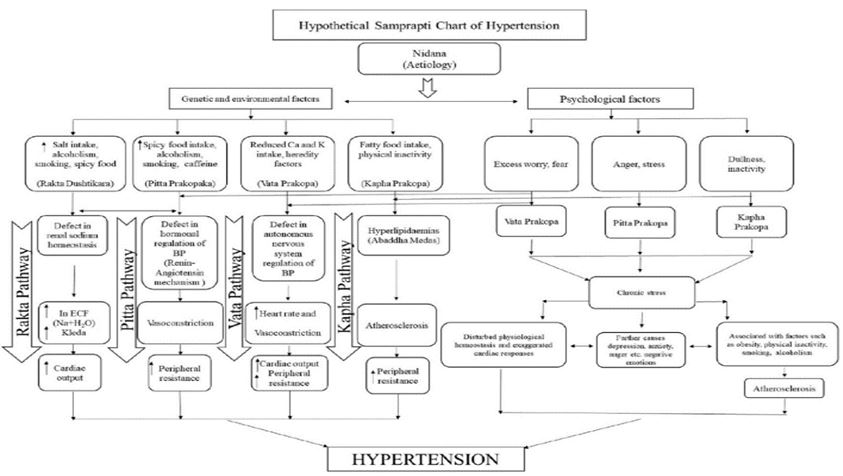Hypertension - An Ayurvedic approach
DOI:
https://doi.org/10.21760/jaims.8.4.22Keywords:
Hypertension, Ayurveda, Doshas, Vata, Pitta, Tridosha, Srotas, AvaranaAbstract
Hypertension is severe high blood pressure caused by a stressful lifestyle, in which the blood vessels have persistently elevated pressure, making it difficult for the heart to pump. Because of this increased pressure on the heart, the pressure on the blood vessels that supply the different tissues and organs of the body increases and can damage the corresponding organs. It is an early stage of pathogenesis and a risk factor for the development of diseases affecting, for example, the heart, brain, kidneys, etc. Many people with hypertension are undiagnosed for a long time or until diagnosed incidentally, so it can be considered a silent killer. About 1.13 billion people worldwide suffer from hypertension, so normalizing abnormally high blood pressure is a difficult task. In Ayurveda, systemic hypertension can be understood as the participation of vitiated Doshas, where Vata and Pitta are the dominant Tridoshas, which prevent the movement of these Doshas in the respective Srotas. The concept of Avarana (occlusion in Dosha functioning in a normal state) gives a better understanding of hypertension, which should be considered for better results in Ayurvedic treatment of diseases. Therefore, an attempt will be made here to understand hypertension from Ayurvedic concepts and to discuss the management of this condition from an Ayurvedic perspective.
Downloads
References
Ambulkar P, Chand T, Rao S, Dwivedi L. (2010) Makardhwaj as a Boon in Hypertension (Vyana Bala Vaishamya): A Clinical Evaluation, Proceedings in National Seminar on Preventive Cardiology in Ayurveda. Rashtriya Ayurveda Vidyapeeth Publication, New Delhi, India, pp. 295-300.
WHO report of Prevention and control for Cardio vascular diseases, 2001-2002, available from http://www.sld.cu/./pdf/./international cardiovascular disease statistics. Page 2
Gupta R. Trends in hypertension epidemiology in India. J Hum Hypertension 2004;18:73-8.
Charaka Samhita, Yadavaji Trikamji, Reprint edition, Chaukhamba Sansrit Sansthana, Varanasi, 2009, Sutrasthana, 18/46: pg 108.
Dhamle Madhumati. Post Graduate Thesis on the study of Yojana Chatushka of Charaka and Yojana for the management of Raktashrita Vyadhi (hypertension). Department of Basic Principles, Institute of Post Graduate Teaching and Research in Ayurveda; 2001.
Patwardhan K. The history of the discovery of blood circulation: unrecognized contributions of Ayurveda masters. Adv Physiol Educ 2012; 36:77e82. https:// doi.org/10.1152/advan.00123.2011
Tripathy Brahmananda, editor. Caraka Samhita of Agnivesha, Charaka Chandrika Hindi commentary. 1st ed. Varanasi: Chaukhamba Orientalia; 1999. p. 558. Chikitsa Sthana; Grahanidosha chikitsa, Chapter-15, Verse 36.
Murthy Srikantha KR, editor. Asthanga Samgraha of Vagbhata. 9th ed. Varanasi: Chowkhamba orientalia; 2012. p. 368. Sutra Sthana, Doshabhedeeya Adhyaya, Chap 20, Verse 2.
Gordan R, Gwathmey JK, Xie L-H. Autonomic and endocrine control of cardiovascular function. World J Cardiol 2015;7(4):204e14. https://doi.org/ 10.4330/wjc.v7.i4.204.
Sembulingam, Sembulingam Prema. Properties of caridiac muscle. Essentials of medical physiology. 5th ed. New Delhi: Jaypee brothers medical publishers (P)Ltd.; 2010. p. 509.
Trikamji J, Ram N, editors. Commentary Nibandha Sangraha of Dalhana on Sushruta Samhita of Sushruta, Sharira Sthana; Dhamaneevyakaranam Shareeram Adhyaya. 1st ed. Varanasi: Chaukhambha Sanskrit Sansthan; 2012. p. 386. Ch. 8, Verse12.
Tripathi B, Samhita C, Adhyaya S 24 (11-17) P-430. In: Chakrapani and Charaka Chandrika (Eds), Chaukhamba Surbharati Prakashan. Vranasi, India.
Sushrutha: Acharya Jadavji Trikamji, Chaukhamba publication, Varanasi, 2000, Uttara Tantra chapter1 sloka 25
Agnivesh, Charaka Samhita, Ayurveda Dipika commentary by Chakrapani Dutta, Chaukamba orientalia, reprint 2014, Chikitsa Sthana chapter 28, sloka 92
J.L.N.shastry, “Dravyaguna VIjnana” Chaukambha orientalia Publications,Varanasi,vol II, 2nd ed-2005,pg395-399.
J.L.N.shastry, “Dravyaguna VIjnana” Chaukambha orientalia Publications,Varanasi,vol II, 2nd ed-2005,pg359-363
J.L.N.shastry, “Dravyaguna VIjnana” Chaukambha orientalia Publications, Varanasi, vol II, 2nd ed-2005,pg375-380.















